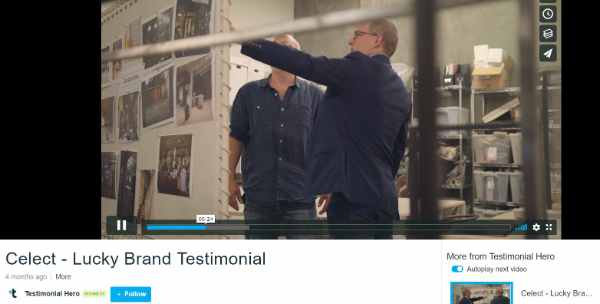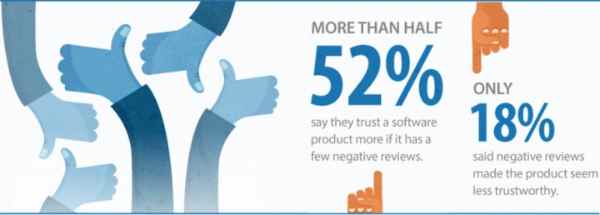Remember that when you’re creating a customer testimonial video, authenticity is key above all else.
By Sam Shepler
Customer testimonial videos can make or break a marketing campaign. The ability of prospective buyers to watch other customers with similar backgrounds and pain points discuss the effectiveness of a product can go a long way toward building trust and confidence in a company.
More than 95% of customers check out customer reviews when trying to decide whether to give their business to a specific company. On the other side of the coin, 79% of B2B content marketers are using videos as a part of their content marketing strategy.

(Image Source)
But not all customer testimonial videos are created equal. It’s not enough to just grab a random satisfied customer, set them up in front of a camera, and upload the raw footage to YouTube. A combination of strong content and production quality have to combine in order to create a truly memorable testimonial that will have a positive impact on your sales numbers.
That’s why we’ve compiled this list of five beneficial items which should be included in all customer testimonial videos, ensuring that messages are delivered in an impactful and memorable way.
1. Visuals in Your Video
Video is a visual medium, and that means that you need to make the testimonial video aesthetically pleasing for your audience. Visual elements help to break up the monotony of a testimonial. They go far beyond just a background set.

(Image Source)
No matter how pretty your set pieces may be, your video needs to feature more than just a straight on shot of the customer. A testimonial video should never be just a static shot of one person sitting in a chair looking directly at a camera. This becomes very boring very fast and could cause a viewer the mentally check out.
Cut away from the customer to show informational images such as charts or graphs that accentuate their points. You could also film re-enactments of some of the stories that they are telling or create some B-Roll footage of their environment to pan through while they talk.
Another way to liven up this content is to shoot the testifying customer from multiple angles. Cutting between two or more cameras creates enough variance so that the viewer does not disengage.
2. Measurable Data
Testimonials mean nothing without proof. That’s why you need to make sure that you’re backing up all of your testimonial videos with hard data.
Make sure that the testimony your customers are giving is not vague or general. Instead, have them give specific information about their journey, backed up by numbers and facts. This helps add validity to the testimony while simultaneously showcasing the product’s effectiveness.

(Image Source)
Providing data also gives you an opportunity to speaks more toward the customer’s specific pain points. Saying that they started off “in the red” is less effective than noting that the company had been losing an average of $15,000 per year for the last three years prior to the implementation of your service.
You can also create imagery to go along with what the customer is saying. If they were $15,000 in the red, show that with some kind of graphic. Then create another informative image that chronicles their increased success.
If your company sells Search Engine Optimization services, have your testifying customer talk about how obscure their business once was and physically show specific increases as to how your customer’s site rose up the search engine ranks.
Your customer testimonial video should never just be a random person sitting there saying, “I like this product.” Remember, specifics help to sell the authenticity of the testimony, so make sure you take generalizations out of the equation.
3. Personal Stories
When dealing with a customer testimonial, you want the prospective buyer to make an emotional connection with the testifying customer. Personal stories can help the viewer feel as though they know the customer and it helps their story feel more authentic.
Customer testimonials work so well because they are not branded company line marketing materials. The way you differentiate one from the other is by appealing to the heart of your audience through personal connections.
Have customers give a little bit of background information on themselves. Casually mentioning that they’re a wife and mother of three small children who runs a law firm can go a long way, but don’t take a ton of time to do this.
The purpose of establishing a personal connection through testimonial videos is for the prospect to be able to see themselves in the customer’s shoes. You need to prove that the testifying customer is just like the viewer. You can do this through personal stories pertaining specifically to the shared pain points that your product or service helps to alleviate.
Once the prospect hears the customer talking candidly about the same pain points that they are hoping to resolve, you instantly have their attention. They will clamor to know how the testifying customer was able to improve their business.
One way to create this personal authenticity is to let the customer talk for a long period of time. You won’t be able to use all of it obviously, but an old adage in film is that it is always better to have too much footage than to not have enough.
Let the customer talk to their heart’s content, allowing their unique personality to shine through. Afterward, comb through the footage for the best or most effective snippets and edit them all together.
4. Specificity
Specificity is extremely important when you’re creating a customer testimonial video. Without specifics, your testimonials are flat, vague, and not effective in any way.
The major problem with vague testimonials is that they just aren’t persuasive. They don’t feel real, which is a major turnoff to prospective customers. The instant they catch even the slightest hint of fakeness, they’re done with you and you’ve probably lost their business forever. The key to the most effective testimonials is for them to not feel staged or scripted.
The other major issue with non-specific testimonials is that they are not exciting. That doesn’t mean you need car crashes and explosions ripping across the screen to create engaging video content. But specifics can be exciting to a prospect who has been struggling with pain points for a long period of time.
To harken back to our example of a company that is more financially minded, if you show someone that went from a loss of $15,000 per year to profits in excess of $50,000, you’ll excite and amaze the viewer. Testimonial effectiveness banks on the viewer being able to place themselves in the testifying customer’s shoes and imagine what it will be like to have that success for themselves.
Specifics create authenticity. Specifics create excitement. In short, specifics create sales.
5. Context
Context is another key area which the most effective customer testimonials hit. Prospects need just the right amount of context to have a testimonial hit with more impact. Too much and they will get bored, too little and they will make no connection with the story that’s being told.
So why is context so important? Context allows the prospect to effectively understand a few key questions.
- Is this person like me?
- Is this product or service relevant to my business?
- Do I trust the testifying customer?
- Do I have a similar situation or challenge as the person in this video?
Context effectively frames the whole story. Storytelling is a vital piece of the testimonial video puzzle. You have to frame the situation so that the prospect understands how the customer was impacted by their pain points, and how their life and business improved as a result of the product in question. That context is sorely needed in order to correctly establish the proper emotional connection needed to move the prospect along into the next stage of the buyer’s journey.
The challenging aspect is having the ability to be efficient with context. You can’t take too much time to get into the benefits of your product, so while context is important, you don’t want to weigh the video down with it. A good rule of thumb is that you want to start talking about specific product benefits within the first 30 seconds of the video, which means that you have precious little space to paint a contextual picture.
6. Emotional Pull
Your video testimonials have to make the prospect feel a strong emotional pull toward the customer and their plight. A good testimonial video should elicit a number of emotions, culminating in happiness at the end for the success that the customer has found with you.
The Journal of Marketing Research discovered that brands which inspire high levels of emotion in their prospects receive as much as three times more word-of-mouth referrals than their competitors.
Make sure that the testifying customer discusses their emotional state and how they felt while using the product or service. If the continued loss of revenue prior to using the product affected them in some negative way, make sure that they talk about it. If they were seeing their dream company on the brink of collapse, have them talk about the emotions involved with that.

(Image Source)
Building that emotional connection helps forge a closer connection to the shared pain points that your prospect is trying to relieve.
It also tugs on the heartstrings of viewers and allows the prospective buyers to place themselves in the customer’s shoes. They will inevitably compare their own emotions to those of the person in the video.
That’s why it’s so important to highlight the challenge or opportunity that the testifying customer was facing. Conflict is emotional. To add to the story, it’s important to understand what problems the person was trying to solve, what the stakes were, and how they were able to fix the issue.
By placing your product at the heart of this emotional story, your company comes out looking all the better in the end.
7. No Scripting
One of the most important rules of creating a testimonial video is to avoid scripting your prospects. Scripted testimonials are painful to watch and a viewer will see through it instantly.
Testimonial videos are like a magic show in some ways. Viewers are constantly looking for a crack in the armor to prove that it is fake or manufactured. The way you combat that is to let the customer just be themselves.
Don’t use cue cards or make them remember a script because the second their testimony becomes wooden or feels as though they are reading something, the entire video falls apart. You’ll lose authenticity in that case, and once that happens you can kiss your prospects goodbye.
Do multiple takes if the customer messes up or starts laughing. You can always edit the video later. The best course of action is to just have a normal conversation. Ask questions that the customer can answer and then edit yourself out later.
Conclusion
Remember that when you’re creating a customer testimonial video, authenticity is key above all else. You want to put the viewer at ease and not give them even a moment to doubt you. If they feel as though they’ve been lied to or that the testimonial was staged and they’re watching a (bad) actor, then they will feel insulted and turned off from your business.
One important factor to keep in mind while implementing these seven items is maintaining a balance. There is a challenge in creating a balance between providing enough context to create that all-important emotional connection while also getting to the point quickly. This is a constant dance that all of the best testimonials do.
If you have a video with no context and all benefits, the testimonial fails. On the other hand, 45 seconds of context before highlighting any benefits can be equally bad. Find that balance and you’ll create a testimonial video that prospects will remember when it comes time to make a purchase decision.
Utilize these seven effective customer testimonial strategies and inspire some hope and trust in your prospective buyers.
Sam Shepler has 10 years of experience producing video testimonials for B2B marketing teams. As both a video producer and a brand marketer, he brings a strategic, big picture, perspective, as well as the hands on tactical production expertise. After selling his last agency, Skyscope, in 2016, Sam is building a new company, Testimonial Hero, specifically focused on providing the worlds best solution for busy marketers who need professional video testimonials.
Video testimonials stock photo by Gustavo Frazao/Shutterstock







